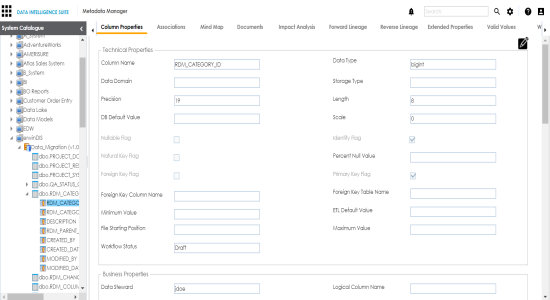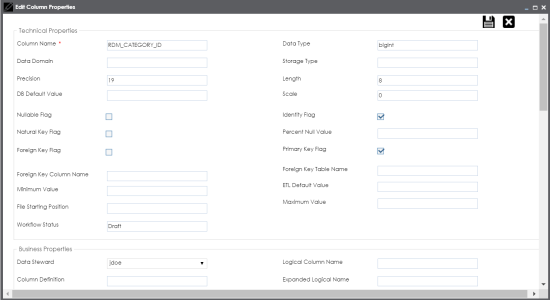Updating Column Properties
Column properties are classified as technical properties and business properties. You can also define your own new properties using user defined fields.
To update Column Properties, follow these steps:
- Go to Application Menu > Data Catalog > Metadata Manager.
- Under the System Catalogue pane, click a column.
- Click
 .
. - Enter appropriate values in the fields. Fields marked with red asterisk are mandatory. Refer to the following table for field descriptions.
- Click
 .
.
The Column Properties page appears.

The Edit Column Properties page appears.

|
Fields |
Description |
|---|---|
| Column Name |
Specifies the physical name of the column. For example, Object_ID. |
| Data Domain |
Specifies the data domain values for the column. For example, data domain of a Gender column is M and F. |
| Precision |
Specifies the precision of the column. For example: 5, the number 123.45 has a precision of 5 and a scale of 2. |
|
DB Default Value |
Specifies the default value of the column in the database. For example, True. |
|
Nullable Flag |
Specifies whether the column allows null values. Select the check box if the column allows null values. |
|
Natural Key Flag |
Specifies whether the column is a natural key. Select the check box if the column is a natural key. |
|
Foreign Key Flag |
Specifies whether the column is a foreign key. Select the check box if the column is a foreign key. |
|
Foreign Key Column Name |
Specifies the actual column name where the column is listed as a PK (in case the current column being an FK). For example, ID. |
|
Minimum Value |
Specifies the minimum value of the column. For example, minimum value of ID column can be 424. |
|
File Starting Position |
Specifies the starting position in the file. |
|
Workflow Status |
Specifies the workflow status of the column. For example, draft. By default, Metadata_Manager_Default_Workflow is assigned to all the columns in the Metadata Manager. You can create and re-assign a workflow to all the columns in a table. For more information on the workflow status, refer to the Assigning Workflows to the Columns topic. |
|
Data Type |
Specifies the physical data type of the column. For example, varchar. |
|
Storage Type |
Specifies the storage type of the column. For example, row store/column store in the case of SAP systems. |
|
Length |
Specifies the physical length of the column. For example, if the column datatype is char(5), then its physical length is 5. |
|
Scale |
Specifies the physical scale of the column. For example: The number 123.45 has a precision of 5 and a scale of 2. |
|
Identity Flag |
Specifies whether the column is used as an identity flag. Select the check box if the column is used as an identity flag. |
|
Percent Null Value |
Specifies the percentage of null values in the column. For example, 10%. |
|
Primary Key Flag |
Specifies whether the column is a primary key. Select the check box if the column is used as the primary key. |
|
Foreign Key Table Name |
Specifies the actual table name where the column is listed as a PK (in case of the current column being an FK). |
|
ETL Default Value |
Specifies the default ETL value of the column during the load process. |
|
Maximum Value |
Specifies the maximum value of the column. For example, maximum value of ID column can be 1503. |
|
Data Steward |
Specifies the data steward responsible for the column. For example, Jane Doe. For more information on configuring list of data stewards, refer to the Configuring Data Stewards topic. |
|
Column Definition |
Specifies the definition of the column. For example: The column is a primary key that allows 5 alpha-numeric characters. |
|
Column Comments |
Specifies the comments about the column. For example: The column provides unique identification of employee in the employee table. |
|
Sensitive Data Indicator (SDI) Flag |
Specifies whether the column contains sensitive data. Select the check box to categorize the data in the column as sensitive. |
|
Sensitive Data Indicator (SDI) Classification |
Specifies the SDI classification of the column. Select the appropriate SDI classification like confidential, internal only, public, or restricted. You can configure SDI classification in Metadata Manager settings. |
|
Column Class |
Specifies the column class property. Select a column class. For more information on configuring column class, refer to the Configuring Table and Column Class topic. |
|
DQ Score |
Specifies the overall data quality score of the column. For example, High (7-8). For more information on configuring DQ scores, refer to the Configuring Data Profiling and DQ Scores topic. |
|
Logical Column Name |
Specifies the logical name of the column. For example, if the physical name of the table is CUST_ID_NUM, then the logical name of the table is Customer Identification Number. |
|
Expanded Logical Name |
Specifies the expanded logical name of the column. For example, if the physical name of the column is Resource_ID, then the logical name of the . You can also configure expanded logical name of columns in bulk at system and environment level. |
|
Used in Gap Analysis |
Specifies whether the column is being used in a gap analysis for usage in mappings. Select the check box if the column is used in the gap analysis. For more information on performing column gap analysis, refer to the Performing Column Gap Analysis topic. |
|
Sensitive Data Indicator (SDI) Description |
Specifies the description of the sensitive data classification of the column. For example: The column contains sensitive data and it is for internal use only. |
|
Column Alias |
Specifies the alias name of the column. For example, Resource_ID. |
|
Business Key Flag |
Specifies whether the column is a business key. Select the check box if the column is a business key. |
The column properties are updated.
You can use user defined fields with different UI labels. For more information on using UI labels for user defined fields, refer to the Configuring Language Settings topic.
You can also hide user defined fields in the Column Properties tab. For more information on hiding user defined fields, refer to the Displaying User Defined Fields topic.
|
Copyright © 2020 erwin, Inc.
All rights reserved.
|
|